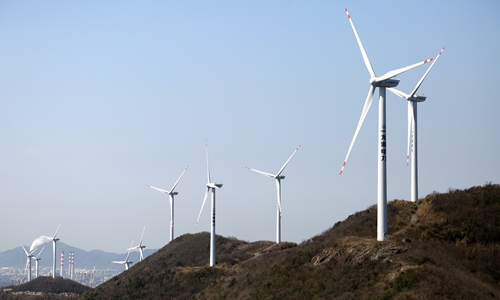Shanghai, other coastal regions vow to achieve peak CO2 emissions ahead of national schedule

On Monday, 17 turbines generate electricity at the Jintangfeng wind farm in Zhoushan, East China’s Zhejiang Province. In 2019, total of 44.59 million kilowatt hours of electricity were fed into the grid, eliminating about 44,500 tons of carbon emissions in theory. Photo: cnsphoto
Several coastal Chinese cities and provinces including Shanghai, Jiangsu and Guangdong have reportedly announced that they aim to achieve peak carbon dioxide emissions before the national schedule of 2030.
Shanghai has set a timetable and plans to achieve peak total and per capita CO2 emissions by 2025, five years ahead of China’s national timeline, the local authorities said.
The city also aims to reduce its total emissions by about 5 percent from the peak by 2035, Cheng Peng, head of the Shanghai Municipal Bureau of Ecology and Environment, said at a press conference on Thursday.
South China’s Guangdong Province and East China’s Jiangsu Province also aim to take the lead in curbing CO2 emissions, news portal thepaper.cn reported on Sunday.
The two coastal provinces’ GDP ranked top and second respectively among all the Chinese mainland provinces in 2019, official statistics showed.
China’s eastern and southern coastal areas, where Shanghai, Jiangsu and Guangdong are located, are likely to have CO2 emissions peak earlier than other domestic regions, environmental experts predicted.
These areas enjoy better industrial structure with fewer heavy-industrial enterprises than northern inland regions, said Huang Dong, a professor at College of Public Administration under Huazhong University of Science and Technology and a member of the China Renewable Energy Society.
“As China’s most developed regions, they have good economic foundations to support local industrial structure optimization, and to deploy more low-energy industries, such as electronic information,” Huang told the Global Times on Monday.
Good economic performance also enables local authorities in these regions to shift the emphasis to sustainable, eco-friendly development. “Shanghai, for instance, has stricter control in pollutant emissions, and the local government is more enthusiastic about energy efficient tech, such as energy-saving buildings and NEVs (new-energy vehicles),” Huang said.
To encourage NEV consumption, Shanghai offered each local NEV purchaser 5,000 yuan ($770) as a charging subsidy last year, on top of existing subsidies.
The city’s energy consumption per 10,000 yuan of GDP has dropped by 17.07 percent from the level in 2015, the local government said.
China aims to have CO2 emissions peak by 2030 and to achieve carbon neutrality by 2060, according to the Xinhua News Agency.



